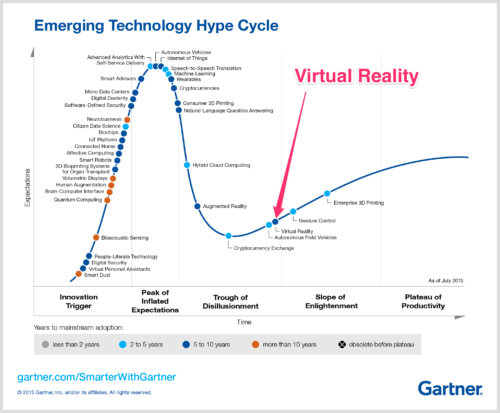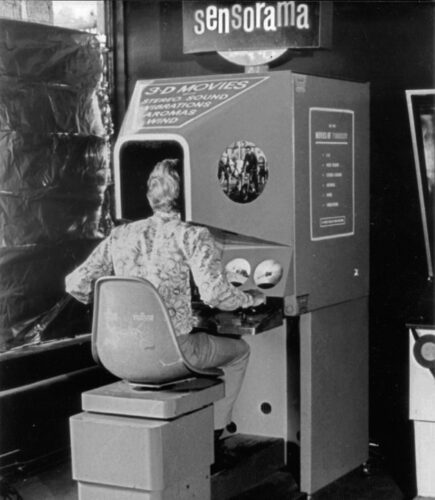Did You Know… Science Behind VR is Older Than You Think
Did you know that the science of VR was discovered as far back as the 1830s? I didn’t either. But with VR being such a hot topic I did some quick research and discovered some interesting insights. The most important thing about VR to remember is that it is not new. And that, while I am very excited about virtual reality training experiences, it is only 1 more tool for your elearning toolkit. It is still your responsibility as a training professional to understand which tool best accommodates your organizations needs.
Virtual Reality is 5 to 10 Years from Mainstream Adoption
I recently presented a session on virtual reality at the Learning Live 2016 event in London. The purpose was to help L&D professionals understand that, despite the resurgent hype of VR, it is not new. In fact, Gartner now has VR well past the trough of disillusionment with a foot strongly planted along the slope of enlightenment. Their estimated timeline to mainstream adoption is 5-10 years. However, in the field of training and development, Virtual Reality is old news.
Mainstream interest in virtual reality fell into the trough of disillusionment shortly after Lawn Mower man in the mid 90s. And looking at the shape of the hype curve you might then put the technology trigger at around the timing of the mainstream computer age in the early 80s…or maybe even back into the 70s.
However, if you look at the technology behind virtual reality you begin to see that people have been attempting to escape reality even further back in time. The Sensorama, patented in 1962, is a great example of attempts at simulating reality in the form of an interactive personal theater experience. And you might even be surprised to know the first flight simulator was built back in the 1920s.
Most virtual reality enthusiasts would probably agree on the 1950s as an appropriate timeframe for the beginning of VR as we know it today.
360 Degree Video is Only One Version of VR
But what is VR “as we know it today?” The term virtual reality is used for many different technologies, but we focus on one for this post: 360 degree video. A user can view a 360 degree video within a headset and the viewer’s perspective changes as they move their head. Google helped reintroduce this viewfinder technology with Google Cardboard. And you find plenty of 360 degree videos on YouTube. You can view them on your desktop and navigate with your mouse, but the experience is far more engaging when viewed within a headset. In some 360 degree videos there is also the sense of depth achieved by using 3D effects. And the science behind that particular illusion goes back to the early 1800s.
The Science of Stereoscopy Discovered in 1830s
Charles Wheatstone is credited with discovering the science of stereoscopy in the 1830s. Wheatstone discovered that the brain processes the information from both eyes separately and puts the two images together to form what we see. It’s the magic of 2.5 inches. This distance separating your eyes is just enough for the brain to render what we perceive as reality.
Applying this science Wheatstone discovered that you could make flat 2D images appear to have depth by displaying 2 images of the same scene to each eye independently. And with one of the images altered slightly to make up for the slightly different angle of view for each eye, caused by the 2.5 inch separation, you create the illusion of depth…of reality.
The Power of the Virtual Reality Experience
The VR experience is powerful because of how easily the brain is tricked into perceiving an artificial space as being real. The more senses you engage, the more easily your brain falls for the illusion. 360 degree video is immersive and engaging, but better VR already exists and is rapidly getting even better. Some of the best VR includes a headset displaying visuals to your eyes, and also includes headphones for audio presence as well. This type of full immersion is amazing and must be experienced to fully appreciate it. However, this technology is also expensive relative to a viewfinder-style viewer, and best applied in very specific training solutions.
360 degree video and the common viewers that currently exist are the perfect enhancement to any video-based training program. Watching a video on a screen is already a great experience for learning, but when that video is recorded in 360 degrees and allows the viewer to “look around” the space, it gets even better.
There will be a lot to learn in the coming months/years about how to best produce and apply 360 degree video. But just remember that it’s not the solution for every training problem. It’s another digital medium to add in your eLearning toolkit. Use it wisely.
HRTech 2016 – Litmos at Booth #1251
If you are new to the VR experience, then stop by the Litmos.com booth at HRTech to try it out. Litmos is always actively experimenting with new learning technologies and we want to know what you think.







